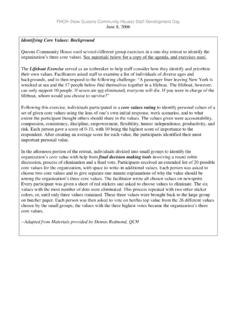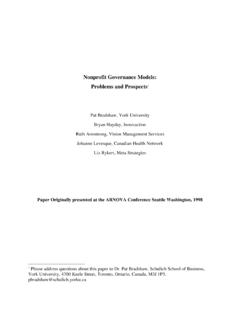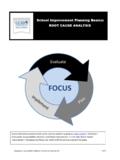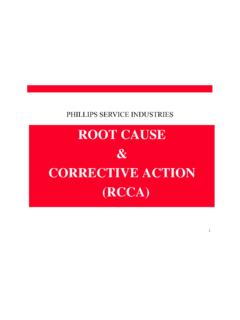Transcription of ROOT CAUSE ANALYSIS - Building Movement Project
1 1 Making visible the often invisible sources of some the problems we deal with every day can be difficult. An essential part of understanding is learning why things operate the way they do, opening up to new ideas, and thinking about the implications of these ideas for your organization s work. Asking why? is a great way to begin identifying the root causes of the problems staff and clients face in their daily lives, and it helps people focus on larger systemic issues. For example, if a group is discussing children s lack of academic success in a neighborhood, the discussion might start by wondering why teachers are not doing more.
2 That might lead to examining the inability of schools or teachers to provide children with individualized attention and customized learning plans because of overcrowding. Then we would ask why?, and that might lead to a discussion about resource allocation, standardized testing, or other elements of education policy. Again, we would ask why? to help people gain a broader perspective on the large societal, cultural, political, and economic structures that influence the lives of children and teachers. PURPOSE OF THIS EXERCISE: This exercise helps service providers and other stakeholders develop a shared understanding of the root causes facing your community and can help connect the work of your agency to individual, community problems and systemic issues.
3 HOPED-FOR OUTCOMES: Understand the definition of a root CAUSE Identify sources of problems in your community Explore why these problems persist INTRODUCTION Creating space for discussions about root CAUSE is important and requires stepping back from the daily work. It may feel like a waste of precious time that could be spent with clients. But to think about and discuss the root causes of problems can have an impact on what we do day-to-day. It can also help us understand on ever a deeper level what the people we work with and sometimes we have to struggle with in order to have better outcomes.
4 You might start by using this exercise with a small group of staff or board members, and then expand out to a larger group. It is important to note that not everyone will agree on the root causes of community problems. As you continue to analyze root causes , you may decide to read articles or hear from guest speakers who can help answer those why questions and broaden your thinking about change in a societal context. The research process can cover a range of topics, from understanding how power works in different communities to analyzing the history of specific policies in the It can also cover the history of certain institutions, such as community development corporations or settlement houses.
5 Use whatever helps deepen your understanding of the systems at work. R O O T C AU S E AN AL Y S I S SAMPLE AGENDA FOR A GROUP EXERCISE Introduction (10 min) Explain that the goal of this exercise is to explore the root causes of the community problems that your organization seeks to address. Make sure that everyone understands what the term root CAUSE means. Ask for volunteers in the group to offer a definition or, if all participants are unfamiliar with the concept, refer to the definition offered in the box. Identify root causes (30 min) Give each participant a copy of the handout on the last page of this tool.
6 Write out your mission statement on a flipchart and have everyone fill it in on their worksheet. Beneath the agency mission, write the following questions: o What problems does our agency s mission seek to address? o What are some of the root causes of these problems? Break into pairs or smaller groups. Give pairs/groups 10-15 minutes to discuss these questions and fill out the first two columns of their handouts. (If you have a small group, you may do this all together.) Bring groups back together to report-out and discuss what they discovered. List the responses on a flipchart or whiteboard.
7 (Note: In facilitating this discussion, it is important to remember and respect the fact that not everyone will agree.) Why do These Problems Persist? (15 min) After the group has developed the list of 2 DEFINITION OF root CAUSE root causes are the underlying factors that create community problems, and make those problems likely to persist even though services may be in place to help individuals and families meet their immediate needs. The concept comes out of science and it refers to problems that keep occurring because we don t get to the root or real CAUSE .
8 Why do These Problems Persist? (15 min) After the group has developed the list of problems addressed by your mission and their root causes , ask the group, What keeps these problems from being solved in a meaningful and permanent way? and What other factors CAUSE these problems to persist? Give participants 5 minutes to write down answers in the third column. Ask people to report-out and record these responses as well. Closing and Evaluation (5 min) Ask people to share: 1. Something they learned, or a moment in the discussion that surprised them. 2. One thing they liked and one thing they would change about the conversation.
9 Close the discussion and thank people for their participation. Note: If there was energy around this discussion, invite people to participate in a follow-up meeting, using the causes and Consequences Tool, which you can find at SAMPLE EXERCISE Problem Youth of color in urban areas have a high drop-out rate. Individual/behavioral CAUSE Examples: youth make bad choices; schools don t know how to keep youth interested; youth want to work, not study; etc. root CAUSE (s) Examples: economically disfranchised communities; schools are under-resourced; etc. What factors CAUSE the root CAUSE to persist?
10 Example: lack of political power among poor and other marginalized communities to secure equitable funding, resources, and accountability within the school systems that serve their children. R O O T C AU S E AN AL Y S I S W R I T E Y O U R M I S S I O N S T A T E M ENT: L I S T T H E P R O B L E M S YOU R M I S S I O N S E E K S T O A D D R E S S: ( o n e p e r b o x ) L I S T S O M E O F T H E R O O T C A U S E S O F E A C H P R O B L E M L I S T F A C T O R S T H A T A RE T H E R E A S O N T H O S E R O OT C A U S E S P E R S I S T W orksheet 3 Copyright 2013 Building Movement Project










